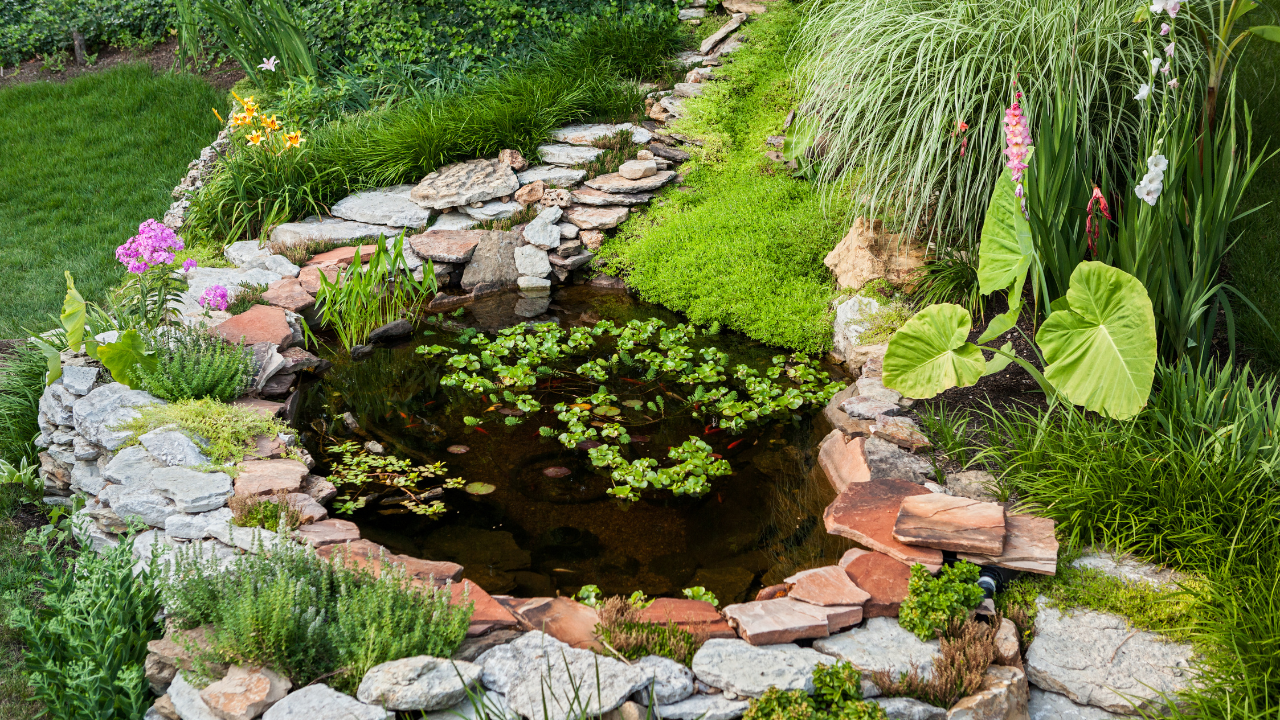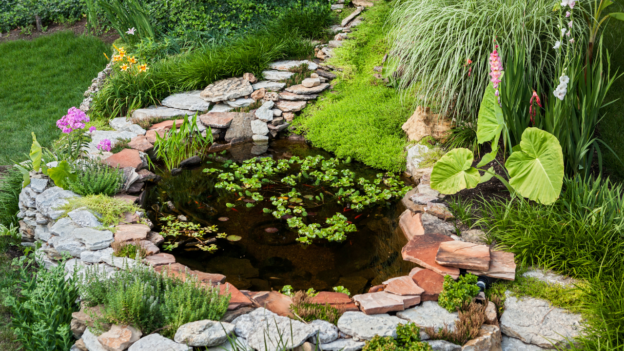
Key Takeaways:
- Essential to prevent murky water and ecosystem issues. Use nets or pond vacuums for debris and muck removal.
- Regularly check and clean your filter and pump to ensure efficient operation and prevent problems like algae growth.
- Trim aquatic plants to maintain balance and prevent overcrowding. Manage external plants to reduce debris.
- Prevent algae growth by managing sunlight exposure and nutrient levels. Use UV clarifiers or algae treatments if necessary.
- Regularly test and maintain water parameters (pH, ammonia, nitrite, nitrate) to ensure a healthy pond environment.
Owning a pond is like having a small piece of nature right in your backyard. It’s serene, it’s beautiful, and let’s be real, it’s a magnet for all kinds of aquatic life.
Like any other valuable possession, a pond requires some love and attention to look at its best. Whether you are an old pond lover or just getting started, here are some pond maintenance tips to help you keep your water clean and healthy all year round.
Regular Cleaning is Key
The first rule of thumb in pond maintenance? Regular cleaning. Though it’s not the most fun part of owning a pond, but trust us, it’s important. Over time, leaves, debris, and even fish waste can accumulate, leading to murky water and potential issues for your pond’s ecosystem.
Start with a basic skim of the surface to remove any floating debris. A net works great for this. If your pond is particularly large or has a lot of plants, you might want to invest in a pond vacuum to help keep the bottom clean. These tools make it easy to suck up any gunk or muck that settles at the bottom, which can help prevent algae growth and keep your water crystal clear.
Get to Know Your Filtration System
Your pond’s filtration system is like its lifeline, keeping the water moving and filtering out all the nasties. But to keep it working efficiently, you need to give it attention from time to time.
Check your filter regularly to make sure it’s not clogged with debris. A clogged filter can lead to poor water circulation, which can cause all sorts of problems, like algae growth or stagnant water. Depending on your filter type, you may need to clean or replace the filter media every few months. While you’re at it, take a look at your pump as well. Make sure it’s functioning correctly and that the water flow is steady.
If you’re not sure where to start or need some professional help, consider reaching out to local experts in pond and fountain repair in Orange County. They can offer guidance, maintenance services, and even repairs if necessary.
Manage Your Plants
Aquatic plants are not only beautiful, but they also play a crucial role in keeping your pond’s ecosystem balanced. They absorb nutrients that would otherwise feed algae and help oxygenate the water. But, like any garden, they need a little bit of pruning and care to keep them from taking over.
Trim back any dead or dying leaves regularly, as these can decompose in the water and contribute to muck buildup. If your plants are growing and starting to crowd your pond, consider thinning them out. This will improve water circulation and give your fish more room to swim.
Don’t forget about the plants outside the pond, too. Trees and shrubs can drop leaves and debris into your pond, so keep them trimmed back to minimize the mess.
Keep Algae Under Control
Algae is the bane of every pond owner’s existence. It can turn your crystal-clear water into a green, soupy mess in no time. The key to controlling algae is to be proactive rather than reactive.
- First off, make sure your pond is getting the right amount of sunlight. While some sunlight is necessary for your pond’s health, too much can fuel algae growth. Consider adding floating plants like water lilies to provide shade and help keep the water temperature down.
- Next, keep an eye on your nutrient levels. Excess nutrients, often from fish waste or decomposing organic matter, are a primary cause of algae blooms. Regular water changes and a well-maintained filtration system can help keep these levels in check.
If you’re still struggling with algae, you might need to bring in the big guns. UV clarifiers and algae treatments can be effective, but make sure to choose pond-safe options. And, if you’re not sure what to use, consult with a professional who specializes in pond fountain parts and supplies in Orange County.
Pay Attention to Water Quality
Keeping your pond’s water quality in check is one of the most important aspects of pond maintenance. Poor water quality can lead to all sorts of problems, from fish health issues to increased algae growth.
Start by testing your water regularly. Test kits are readily available and can help you monitor important parameters like pH, ammonia, nitrite, and nitrate levels. Ideally, your pond’s pH should be between 6.5 and 8.5. Ammonia and nitrite levels should be as close to zero as possible, while nitrate levels should be kept low.
If you notice any imbalances, take action quickly. Water changes are often the easiest way to correct issues, but you might also need to adjust your feeding routine or add beneficial bacteria to your pond to help break down waste.
Don’t Forget About Winter
If you’re in a colder climate, winter can be a tough time for your pond. But with a little preparation, you can help your pond and its inhabitants survive the chilly months.
- First, consider investing in a pond heater or de-icer. These devices keep a small area of your pond ice-free, allowing harmful gases to escape and oxygen to enter the water. This is especially important if you have fish in your pond, as they can suffocate if the pond freezes over completely.
- Before winter sets in, clean your pond thoroughly and remove any dead plant material. This will help reduce the amount of debris that could decompose and cause water quality issues over the winter.
- Lastly, if you have a pond with a pump and filter, consider shutting it down for the season. Running a pump in freezing temperatures can cause damage to the equipment, so it’s often best to store it away until spring.
Invest in Quality Pond Supplies
Maintaining a healthy pond isn’t just about what you do. It’s also about the quality of the products you use. Investing in quality pond supplies can make a huge difference in terms of how easy it is to keep your pond looking great.
From pumps and filters to algae treatments and fish food, choosing high-quality products designed specifically for ponds will give you better results and fewer headaches. And when you need new parts or supplies, be sure to check out trusted local sources. If you’re in Orange County, OC Pond & Fountain Care has a wide selection of pond fountain parts and supplies in Orange County that can help you find exactly what you need.
Consider Professional Help
Sometimes, despite your best efforts, you might find yourself facing a pond problem that’s just too big to handle on your own. That’s when it’s time to call in the professionals. Whether you need a full pond cleanout, repairs, or even just some expert advice, there are professionals who specialize in pond and fountain repair in Orange County. We can help you get your pond back on track and keep it looking beautiful year-round.
